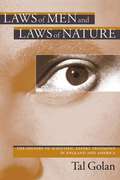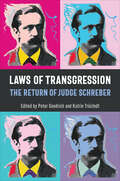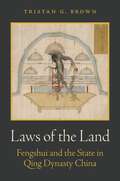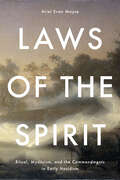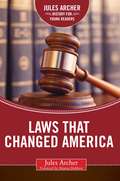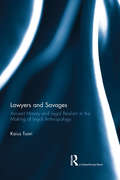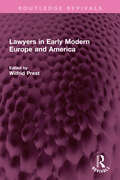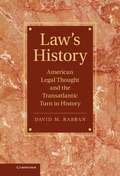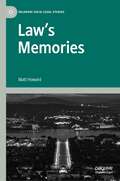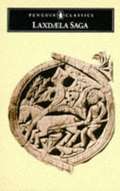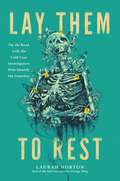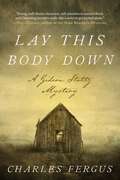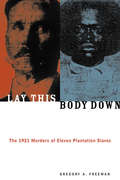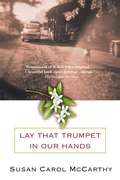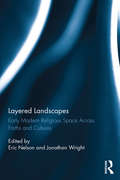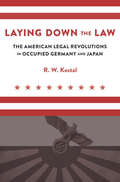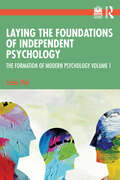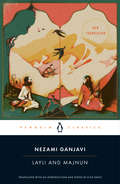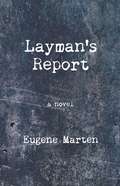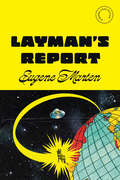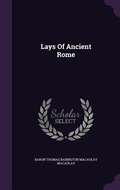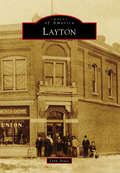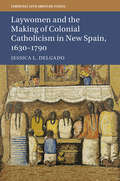- Table View
- List View
Laws of Men and Laws of Nature: The History of Scientific Expert Testimony in England and America
by Tal GolanAre scientific expert witnesses partisans, or spokesmen for objective science? This ambiguity has troubled the relations between scientists and the legal system for more than 200 years. Modern expert testimony first appeared in the late eighteenth century, and while its use steadily increased throughout the nineteenth century, in cases involving everything from patents to X-rays, the respect paid to it steadily declined, inside and outside of the courtroom. With deep learning and wry humor, Tal Golan tells stories of courtroom drama and confusion and media jeering on both sides of the Atlantic, until the start of the twenty-first century, as the courts still search for ways that will allow them to distinguish between good and bad science.
Laws of Transgression: The Return of Judge Schreber
by Peter Goodrich Katrin TrüstedtLaws of Transgression offers multiple perspectives on the story of Daniel Paul Schreber (1842–1911), a chamber president of the German Supreme Court who was institutionalized after claiming God had communicated with him, desiring to make him into a woman. Schreber was not only a successful judge, but was also to become the author of one of the most commented upon texts in psychiatric literature, Memoirs of My Nervous Illness. Published in 1903, this remarkable work documented Schreber’s visions, desires, jurisprudence, and theology. Far from ending the judge’s legal investments, it manifested an intensification of engagement with the law in the attempt to prove that becoming a woman did not deprive the judge of legal competence. Schreber’s experience of bodily change and his account of interior life has been the subject of more than a century of psychoanalytic and medical scrutiny. With the contemporary trans turn, interest in the judge’s desire to become a woman has intensified. In Laws of Transgression, Peter Goodrich, Katrin Trüstedt, and contributing authors set out to unfold Schreber’s complex relation to the law. The collection revisits and rediscovers the Memoirs, not only in its juridical and political implications, but as a transgressional text that has challenged law and heteronormativity.
Laws of the Land: Fengshui and the State in Qing Dynasty China
by Tristan G. BrownA groundbreaking history of fengshui’s roles in public life and law during China’s last imperial dynastyToday the term fengshui, which literally means “wind and water,” is recognized around the world. Yet few know exactly what it means, let alone its fascinating history. In Laws of the Land, Tristan Brown tells the story of the important roles—especially legal ones—played by fengshui in Chinese society during China’s last imperial dynasty, the Manchu Qing (1644–1912).Employing archives from Mainland China and Taiwan that have only recently become available, this is the first book to document fengshui’s invocations in Chinese law during the Qing dynasty. Facing a growing population, dwindling natural resources, and an overburdened rural government, judicial administrators across China grappled with disputes and petitions about fengshui in their efforts to sustain forestry, farming, mining, and city planning. Laws of the Land offers a radically new interpretation of these legal arrangements: they worked. An intelligent, considered, and sustained engagement with fengshui on the ground helped the imperial state keep the peace and maintain its legitimacy, especially during the increasingly turbulent decades of the nineteenth century. As the century came to an end, contentious debates over industrialization swept across the bureaucracy, with fengshui invoked by officials and scholars opposed to the establishment of railways, telegraphs, and foreign-owned mines.Demonstrating that the only way to understand those debates and their profound stakes is to grasp fengshui’s longstanding roles in Chinese public life, Laws of the Land rethinks key issues in the history of Chinese law, politics, science, religion, and economics.
Laws of the Spirit: Ritual, Mysticism, and the Commandments in Early Hasidism (Stanford Studies in Jewish History and Culture)
by Ariel Evan MayseThe compelling vision of religious life and practice found in Hasidic sources has made it the most enduring and successful Jewish movement of spiritual renewal of all time. In this book, Ariel Evan Mayse grapples with one of Hasidism's most vexing questions: how did a religious movement known for its radical views about immanence, revelation, and the imperative to serve God with joy simultaneously produce strict adherence to the structures and obligations of Jewish law? Exploring the movement from its emergence in the mid-1700s until 1815, Mayse argues that the exceptionality of Hasidism lies not in whether its leaders broke or upheld rabbinic norms, but in the movement's vivid attempt to rethink the purpose of Jewish ritual and practice. Rather than focusing on the commandments as law, he turns to the methods and vocabulary of ritual studies as a more productive way to reckon with the contradictions and tensions of this religious movement as well as its remarkable intellectual vitality. Mayse examines the full range of Hasidic texts from the eighteenth and early nineteenth centuries, from homilies and theological treatises to hagiography, letters, and legal writings, reading them together with contemporary theories of ritual. Arguing against the notion that spiritual integrity requires unshackling oneself from tradition, Laws of the Spirit is a sweeping attempt to rethink the meaning and significance of religious practice in early Hasidism.
Laws that Changed America
by Jules Archer Brianna DuMontJules Archer begins with laws that opened up America—public lands and homesteading—and continues with banking, the Bill of Rights, subversion and sedition, foreign policy. Natural resources, labor, business, education and welfare, farming, Prohibition, the New Deal, the draft and G. I. Bills, slavery and civil rights. Archer chronicles the history of laws in America.Each chapter opens with a dramatic incident, and then develops the laws relating to it. Brisk up-to-date, authoritative, informative—this volume will be valuable a supplementary reading in the classroom, as well as a welcome addition to libraries across the country. Readers of all ages will find this an exciting approach to what is usually considered difficult material.
Lawyers and Savages: Ancient History and Legal Realism in the Making of Legal Anthropology
by Kaius TuoriLegal primitivism was a complex phenomenon that combined the study of early European legal traditions with studies of the legal customs of indigenous peoples. Lawyers and Savages: Ancient History and Legal Realism in the Making of Legal Anthropology explores the rise and fall of legal primitivism, and its connection to the colonial encounter. Through examples such as blood feuds, communalism, ordeals, ritual formalism and polygamy, this book traces the intellectual revolution of legal anthropology and demonstrates how this scholarship had a clear impact in legitimating the colonial experience. Detailing how legal realism drew on anthropology in order to help counter the hypothetical constructs of legal formalism, this book also shows how, despite their explicit rejection, the central themes of primitive law continue to influence current ideas – about indigenous legal systems, but also of the place and role of law in development. Written in an engaging style and rich in examples from history and literature, this book will be invaluable to those with interests in legal realism, legal history or legal anthropology.
Lawyers in Early Modern Europe and America (Routledge Revivals)
by Wilfrid PrestFirst published in 1981, Lawyers in Early Modern Europe and America aims to present a convenient conspectus on the legal professions in early modern Europe, Scotland, France Spain and Colonial America, and to provide a comparative perspective on the place of the legal profession in Western societies before the Industrial Revolution. The main themes covered by each contributor are: the status, number and vocational functions of the different classes or groups or lawyers; their social origins; education and career patterns; relations between lawyers and clients, other occupations and status-groups and the state; the extent of legal ‘professionalisation’ and the role of lawyers as ‘modernisers’ in cultural, economic, political and social terms. This book will be of interest to students of history, law and political science.
Law’s Abnegation
by Adrian VermeuleAdrian Vermeule argues that the arc of law has bent steadily toward deference to the administrative state, which has greater democratic legitimacy and technical competence to confront issues such as climate change, terrorism, and biotechnology. The state did not shove lawyers and judges out of the way; they moved freely to the margins of power.
Law’s History
by David M. RabbanThis is a study of the central role of history in late nineteenth-century American legal thought. In the decades following the Civil War, the founding generation of professional legal scholars in the United States drew from the evolutionary social thought that pervaded Western intellectual life on both sides of the Atlantic. Their historical analysis of law as an inductive science rejected deductive theories and supported moderate legal reform, conclusions that challenge conventional accounts of legal formalism. Unprecedented in its coverage and its innovative conclusions about major American legal thinkers from the Civil War to the present, the book combines transatlantic intellectual history, legal history, the history of legal thought, historiography, jurisprudence, constitutional theory and the history of higher education.
Law’s Memories (Palgrave Socio-Legal Studies)
by Matt HowardThis book discusses the relationship between law and memory and explores the ways in which memory can be thought of as contributing to legal socialization and legal meaning-making. Against a backdrop of critical legal pluralism which examines the distributedness of law(s), this book introduces the notion of mnemonic legality. It emphasises memory as a resource of law rather than an object of law, on the basis of how it substantiates senses of belonging and comes to frame inclusions and exclusions from a national community on the basis of linear-trajectory and growth narratives of nationhood. Overall, it explores the sensorial and affective foundations of law, implicating memory and perceptions of belonging within this process of creating legality and legitimacy. By identifying how memory comes to shape and inform notions of law, it contributes to legal consciousness research and to important questions informing much socio-legal research.
Laxdaela Saga
by Magnus Magnusson Hermann PalssonWritten around 1245 by an unknown author, the Laxdaela Saga is a tale of conflicting kinships and passionate love, a compelling work of Icelandic literature.
Lay Them to Rest: On the Road with the Cold Case Investigators Who Identify the Nameless
by Laurah NortonTake a fascinating deep dive into the dark world of forensic science as experts team up to solve the identity of an unknown woman by exploring the rapidly evolving techniques being used to break the most notorious cold cases. Fans of true crime shows like CSI, NCIS, Criminal Minds, and Law and Order know that when it comes to &“getting the bad guy&” behind bars, your best chance of success boils down to the strength of your evidence—and the forensic science used to obtain it. Beyond the silver screen, forensic science has been used for decades to help solve even the most tough-to-crack cases. In 2018, the accused Golden State Killer, Joseph DeAngelo, was finally apprehended after a decades-long investigation thanks to a very recent technique called forensic genealogy, which has since led to the closure of hundreds of cold cases, bringing long-awaited justice to victims and families alike. But when it comes to solving these incredibly difficult cases, forensic genealogy is just the tip of the iceberg—and many readers have no idea just how far down that iceberg goes. For Laurah Norton, forensic science was always more of a passion than anything else. But after learning about a mishandled 1990s cold case involving missing twins, she was spurred to action, eventually creating a massively popular podcast and building a platform that helped bring widespread attention and resources to the case. LAY THEM TO REST builds on Laurah&’s fascination with these investigations, introducing readers to the history and evolution of forensic science, from the death masks used in Ancient Rome to the 3-D facial reconstruction technology used today. Incorporating the stories of real-life John & Jane Does from around the world, Laurah also examines how changing identification methods have helped solve the most iconic cold cases. Along the way readers will also get to see Laurah solve a case in real time with forensic anthropologist Dr. Amy Michael, as they try to determine the identity of &“Ina&” Jane Doe, a woman whose head was found in a brush in an Illinois park in 1993. More than just a chronicle of the history of forensics, LAY THEM TO REST is also a celebration of the growing field of experts, forensic artists, and anthropologists (many of whom Laurah talks to in the book), who work tirelessly to bring closure to these unsolved cases. And of course, this book asks why some cases go unsolved, highlighting the &“missing missing,&” the sex workers, undocumented, the cases that so desperately need our attention, but so rarely get it. Engrossing, informative, heartbreaking, and hopeful, LAY THEM TO REST is a deep dive into the world of forensic science, showing readers how far we&’ve come in cracking cases and catching killers, and illuminating just how far we have yet to go.
Lay This Body Down: A Gideon Stoltz Mystery (Gideon Stoltz Mystery Series)
by Charles Fergus"Richly textured historical fiction with the urgency of a mystery novel. Fergus knows certain things, deep in the bone: horses, hunting, the folkways of rural places, and he weaves this wisdom into a stirring tale.&” – Geraldine Brooks, author of March and People of the Book and HorseLay This Body Down, the third Gideon Stoltz Mystery, takes place in 1837 during one of the most horrific periods in pre-Civil War America, when human beings were considered chattel and both northern and southern states grew rich from slave labor. A Pennsylvania sheriff like Gideon could choose to uphold the federal Fugitive Slave Act of 1793 or defy that racist law at great peril. In this hard-hitting, action-packed novel, Gideon tries to protect a boy who has fled north from a Virginia plantation – and pays dearly for his principles. Written with the vivid, atmospheric prose that imbues the whole series, the life and times of an early American backwoods town and its hardscrabble citizens will grip readers as Gideon and his wife True solve a murder, bust a kidnapping ring, and help one unforgettable boy who courageously chooses freedom above all else.
Lay This Body Down: The 1921 Murders of Eleven Plantation Slaves
by Gregory A. FreemanThe John S. Williams plantation in Georgia was operated largely with the labor of slaves--and this was in 1921, 56 years after the Civil War. Williams was not alone in using "peons," but his reaction to a federal investigation was almost unbelievable: he decided to destroy the evidence. Enlisting the aid of his trusted black farm boss, Clyde Manning, he began methodically killing his slaves. As this true story unfolds, each detail seems more shocking, and surprises continue in the aftermath, with a sensational trial galvanizing the nation and marking a turning point in the treatment of black Americans.
Lay that Trumpet in our Hands
by Susan MccarthyIn 1951, Florida suffers many Ku Klux Klan attacks. After her friend is killed, 12-year-old Reesa struggles to understand racism. Eventually, Reesa's home and family become the unofficial center of the resistance movement.
Layered Landscapes: Early Modern Religious Space Across Faiths and Cultures
by Jonathan Wright Eric NelsonThis volume explores the conceptualization and construction of sacred space in a wide variety of faith traditions: Christianity, Hinduism, Islam, Judaism, and the religions of Japan. It deploys the notion of "layered landscapes" in order to trace the accretions of praxis and belief, the tensions between old and new devotional patterns, and the imposition of new religious ideas and behaviors on pre-existing religious landscapes in a series of carefully chosen locales: Cuzco, Edo, Geneva, Granada, Herat, Istanbul, Jerusalem, Kanchipuram, Paris, Philadelphia, Prague, and Rome. Some chapters hone in on the process of imposing novel religious beliefs, while others focus on how vestiges of displaced faiths endured. The intersection of sacred landscapes with political power, the world of ritual, and the expression of broader cultural and social identity are also examined. Crucially, the volume reveals that the creation of sacred space frequently involved more than religious buildings and was a work of historical imagination and textual expression. While a book of contrasts as much as comparisons, the volume demonstrates that vital questions about the location of the sacred and its reification in the landscape were posed by religious believers across the early-modern world.
Layers In Husserl's Phenomonology
by Peter R. CostelloLayers in Husserl's Phenomenology provides close readings and analyses of a number of Husserl's key translated and untranslated works across the entirety of his corpus. While maintaining a dialogue with four decades' worth of scholarship on Husserl, Peter R. Costello provides a number of new and significant insights that depart from earlier interpretations of his work, along with a revised, consistent translation of a number of important Husserlian terms.Layers in Husserl's Phenomenology situates Husserl firmly within the trajectory of later Continental thought and contributes to the recent reconsideration of Husserl as a legitimate precursor to the thought of Maurice Merleau-Ponty, Emmanuel Levinas, and Jacques Derrida. Written in a readable style appropriate for both undergraduate and graduate students, this study will be valued by those interested in phenomenology in general and in Husserl in particular.
Laying Down the Law: The American Legal Revolutions in Occupied Germany and Japan
by R. W. KostalAfter WWII, U.S. leaders sought to create liberal rule-of-law regimes in Germany and Japan, but the effort was often unsuccessful. Kostal argues that the manifest failings of America’s own rule-of-law democracy were partially to blame, weakening U.S. credibility and resolve and revealing the country’s ambiguous status as a global moral authority.
Laying the Foundations of Independent Psychology: The Formation of Modern Psychology Volume 1 (The Formation of Modern Psychology)
by Csaba PléhPart of a two-volume series, this book offers a multicentric perspective on the history of psychology, situating its development in relation to developments made in other social sciences and philosophical disciplines. This first volume, Laying the Foundations of Independent Psychology, provides a detailed exploration of the origins and development of European psychology. The book examines psychology’s beginnings as an independent discipline in the late 19th century through to the emergence of the dominant new schools of behaviorism, Gestalt psychology and psychoanalysis in the early 1900s. This volume also offers a broad overview of the early impact of Darwinism, not only on the psychological study of individual differences and on American functionalism, but also on the early evolutionary treatments of cognition in William James, James Baldwin, Ernst Mach and even Sigmund Freud. Taking this wider perspective, the book shows that European psychology was continuously present and active, placing these European developments in their own context in their own time. An invaluable introductory text for undergraduate students of the history of psychology, the book will also appeal to postgraduates, academics and those interested in psychology or the history of science, as well as graduate students of psychology, biology, sociology and anthropology with a theoretical interest.
Layli and Majnun
by Nezami GanjaviThe Persian epic that inspired Eric Clapton's unforgettable love song "Layla" and that Lord Byron called "the Romeo and Juliet of the East," in a masterly new translationA Penguin ClassicThe iconic love story of the Middle East, by a twelfth-century Persian poet who has been compared to Shakespeare for his subtlety, inventiveness, and dramatic force, Layli and Majnun tells of star-crossed lovers whose union is tragically thwarted by their families and whose passion continues to ripple out across the centuries. Theirs is a love that lasts a lifetime, and in Nezami's immortal telling, erotic longing blends with spiritual self-denial in an allegory of Sufi aspiration, as the amenities of civilization give way to the elemental wilderness, desire is sublimated into a mystical renunciation of the physical world, and the soul confronts its essence. This is a tour de force of Persian literature, in a translation that captures the extraordinary power and virtuosity of the original.
Layman's Report
by Eugene MartenFred. An ordinary man. Repairs office copiers by day, works on his own inventions by night. Fred. Builds a better electric chair, patents a lethal injection machine, corners the capital punishment market. Fred. Looks for love, finds it in the arms of the Holocaust-denial movement-for better or for worse.Inspired by the life of Fred A. Leuchter, Jr., subject of the Errol Morris documentary, Mr. Death, Layman's Report starts with the truth and takes it where only great fiction can.Eugene Marten is the author of Waste, In the Blind, and Firework. He resides in South Dakota.
Layman's Report
by Eugene MartenA disturbing, darkly funny fictionalization of the life of Fred A. Leuchter, the garage tinkerer turned execution authority who became a darling of the neo-Nazi movement, and subject of the Errol Morris documentary, Mr. Death.He comes to fix your photocopier, but really, Fred&’s an inventor. At night, he goes to work. He has goals, ambitions, and when offered the task of building a better electric chair, he jumps at the chance. People have to die—he believes in the occasional necessity of evil—but what if we could kill them more humanely?A death specialist, first in his field but forever under-appreciated, he&’s charmed when a new generation of fascists come calling for his expertise. A Holocaust denier is on trial in Toronto—could Fred prove the gas chambers never existed? Newspapers descend. Talking heads have their say. A documentarist makes a film. Everyone will know his name, though some things society will simply not abide. Dishonoured, discredited, disgraced. But Fred&’s work does not stop, and the world may yet be reminded of the dangerous truth that some men are driven by forces far more powerful than shame. First published in 2013, this is the updated and definitive edition of Eugene Marten&’s chilling masterwork of transformational historical fiction.
Lays of Ancient Rome
by Thomas Babington MacaulayThis antique book is a collection of critical and historical essays by Lord Macaulay. Included are works from ancient Rome.
Layton (Images of America)
by Lynn AraveLayton was settled in 1850 by pioneers in the Church of Jesus Christ of Latter-day Saints. An outgrowth of Kaysville, Layton separated in 1902 following a 20-year legal battle. The city incorporated in 1920. The Layton Sugar Plant opened in 1915, and the town was an agricultural and ranching hub until 1941, when the United States entered World War II. In less than 10 years, by 1950, Layton's population had tripled, mainly because of Hill Field, a US Air Force maintenance base. Today, Layton is the largest city in Davis County and a regional retail center, anchored by the Layton Hills Mall. It is well known for its "Restaurant Row;" Commons Park, which boasts an extensive collection of lighted animal figures during the holidays; the Ed Kenley Amphitheater; the Adams Canyon trail; and much more.
Laywomen and the Making of Colonial Catholicism in New Spain, 1630–1790 (Cambridge Latin American Studies #110)
by Jessica L. DelgadoIn the first history of laywomen and the church in colonial Mexico, Jessica L. Delgado shows how laywomen participated in and shaped religious culture in significant ways by engaging creatively with gendered theology about women, sin, and guilt in their interactions with church sacraments, institutions, and authorities. Taking a thematic approach, using stories of individuals, institutions, and ideas, Delgado illuminates the diverse experiences of urban and rural women of Indigenous, Spanish, and African descent. By centering the choices these women made in their devotional lives and in their relationships to the aspects of the church they regularly encountered, this study expands and challenges our understandings of the church's role in colonial society, the role of religion in gendered and racialized power, and the role of ordinary women in the making of colonial religious culture.
